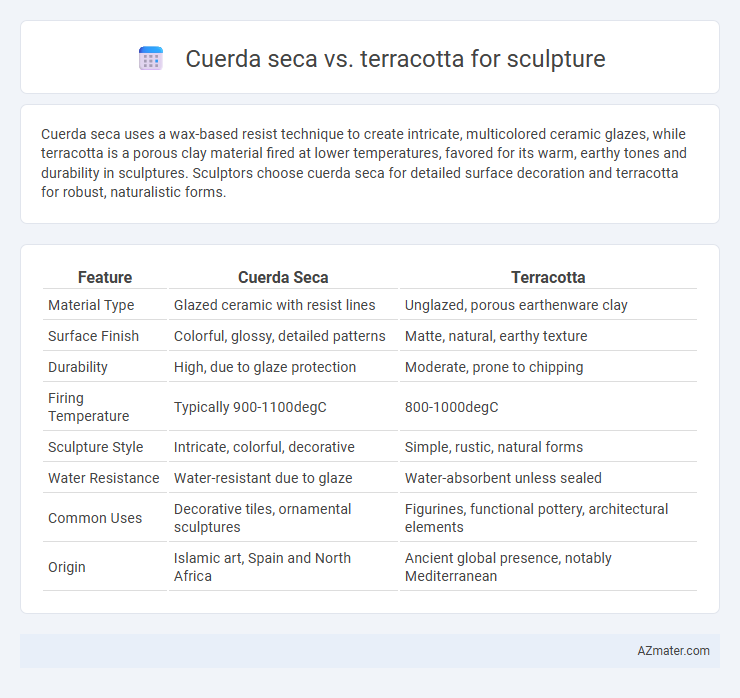Cuerda seca uses a wax-based resist technique to create intricate, multicolored ceramic glazes, while terracotta is a porous clay material fired at lower temperatures, favored for its warm, earthy tones and durability in sculptures. Sculptors choose cuerda seca for detailed surface decoration and terracotta for robust, naturalistic forms.
Table of Comparison
| Feature | Cuerda Seca | Terracotta |
|---|---|---|
| Material Type | Glazed ceramic with resist lines | Unglazed, porous earthenware clay |
| Surface Finish | Colorful, glossy, detailed patterns | Matte, natural, earthy texture |
| Durability | High, due to glaze protection | Moderate, prone to chipping |
| Firing Temperature | Typically 900-1100degC | 800-1000degC |
| Sculpture Style | Intricate, colorful, decorative | Simple, rustic, natural forms |
| Water Resistance | Water-resistant due to glaze | Water-absorbent unless sealed |
| Common Uses | Decorative tiles, ornamental sculptures | Figurines, functional pottery, architectural elements |
| Origin | Islamic art, Spain and North Africa | Ancient global presence, notably Mediterranean |
Introduction: Cuerda Seca vs Terracotta in Sculpture
Cuerda seca and terracotta represent two distinct techniques in sculpture, each offering unique aesthetic and functional qualities. Cuerda seca, a decorative glazing method originating from Islamic art, allows for vibrant color application on ceramic surfaces through the use of wax resist lines to separate pigments. Terracotta, a traditional sculpting material made from fired clay, provides warm earthy tones and a versatile medium favored for detailed three-dimensional forms and durability.
Historical Origins of Cuerda Seca and Terracotta
Cuerda seca, originating in 10th-century Islamic Spain, is a ceramic technique characterized by using greasy lines to separate colored glazes, producing intricate patterns often seen in architectural tiles and decorative art. Terracotta, dating back to ancient civilizations like Mesopotamia and the Indus Valley around 7000 BCE, involves molding and firing clay to create durable sculptures and pottery, widely used for both functional and artistic purposes. Both techniques showcase distinct cultural heritages: cuerda seca reflects Islamic artistic innovation, while terracotta embodies a fundamental material utilized across diverse early societies for sculptural expression.
Material Composition and Properties
Cuerda seca utilizes glazed ceramic tiles with colored slip and a greasy resist line, creating vibrant, waterproof surfaces ideal for intricate decorative sculptures. Terracotta, composed of natural, porous clay fired at lower temperatures, offers a warm, earthy texture and excellent moldability for sculptural forms but is more susceptible to moisture damage. The choice between cuerda seca and terracotta hinges on the desired durability, surface finish, and resistance to environmental factors in sculpture creation.
Techniques and Processes Compared
Cuerda seca involves applying a resist line of greasy substance to separate colored glazes during firing, creating intricate, vibrant patterns on ceramic surfaces. Terracotta sculptures are crafted from porous, earthen clay shaped by hand or mold, then fired to achieve a reddish-brown finish without glaze. While cuerda seca emphasizes decorative glazing techniques ideal for detailed surface art, terracotta focuses on form and texture achieved through clay modeling and kiln firing.
Visual Aesthetics: Color, Texture, and Finish
Cuerda seca offers vibrant, glossy colors with intricate patterns created by resist lines, resulting in a polished finish that enhances visual complexity. Terracotta provides earthy, warm tones with a matte, natural texture that highlights the raw, tactile quality of the clay. The choice between them hinges on whether the desired sculpture favors vivid, detailed surface decoration or a rustic, organic aesthetic.
Durability and Longevity in Sculpture
Cuerda seca techniques involve applying colored glazes separated by wax lines on ceramics, creating intricate surface designs but with moderate durability due to the glazed surface's vulnerability to chipping. Terracotta sculptures, crafted from fired clay, offer high durability and excellent longevity when properly fired and sealed, as their solid earthenware composition withstands weathering and physical wear effectively. For outdoor or long-term sculptures, terracotta provides superior resistance to environmental factors compared to the delicate glazed surfaces of cuerda seca ceramics.
Artistic Applications and Styles
Cuerda seca technique, known for its vibrant polychrome glazes separated by wax resist lines, is ideal for intricate decorative surfaces and detailed narrative scenes in ceramic sculpture, offering a luminous, mosaic-like effect. Terracotta, valued for its warm, earthy tones and malleability, enables sculptors to create expressive, tactile forms ranging from classical figurines to contemporary abstract sculptures, emphasizing texture and form over color. Both mediums support diverse artistic styles, with cuerda seca excelling in ornamental and pattern-rich aesthetics, while terracotta lends itself to robust, sculptural modeling and direct manipulation.
Maintenance and Preservation Considerations
Cuerda seca tiles require careful cleaning with non-abrasive materials to prevent glaze damage, while terracotta sculptures demand periodic sealing to avoid moisture absorption and cracking. Both materials benefit from stable environmental conditions, but terracotta is more sensitive to humidity fluctuations, necessitating controlled indoor display or storage. Preservation of cuerda seca involves monitoring for glaze crazing and avoiding harsh chemicals, whereas terracotta maintenance focuses on preventing salt efflorescence and physical erosion.
Cost and Accessibility for Artists
Cuerda seca techniques typically incur higher costs due to specialized glazes and the precision required, making materials less accessible to emerging artists. In contrast, terracotta offers a more affordable and widely available medium, as clay supplies and traditional firing methods are easier to source and manage. Artists prioritizing budget and material accessibility often prefer terracotta for sculptural work due to its simplicity and lower financial barrier to entry.
Choosing the Right Medium: Key Considerations
Choosing between cuerda seca and terracotta for sculpture involves evaluating durability, texture, and color vibrancy. Cuerda seca offers vivid, intricate patterns through a wax-resistant resist technique ideal for decorative pieces, while terracotta provides a warm, earthy tone with excellent malleability and structural strength suited for traditional sculpting. Consider the intended environmental exposure, desired aesthetic effects, and the artist's technical skill when selecting the right medium.

Infographic: Cuerda seca vs Terracotta for Sculpture
 azmater.com
azmater.com